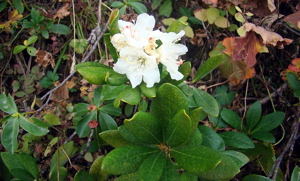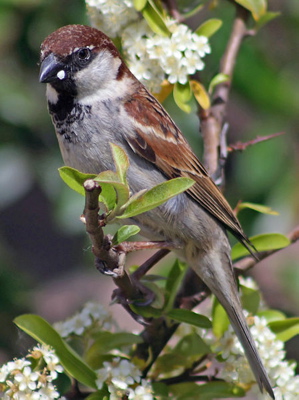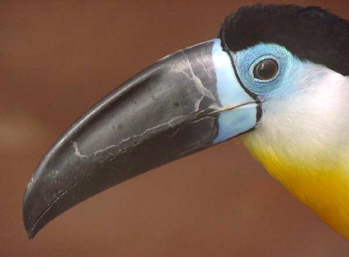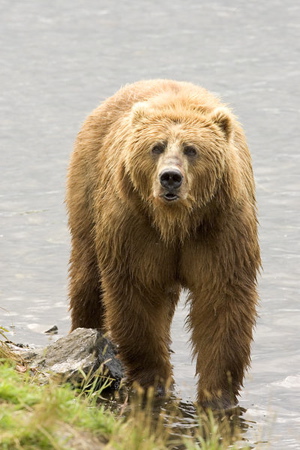On the Origins of New Forms of Life
2.5: Hybrid Taxa
(Continued from the previous page)
There are many hybrid populations and hybrid specimens that have been treated as species or subspecies. Indeed, among botanists such practice is standard, since it is now well accepted that many plants treated as species had hybrid origins. For example, it is now well known that Helianthus anomalus (western sunflower) and H. paradoxus (paradox sunflower) are both natural hybrids derived from the cross H. annuus × H. petiolaris.
A long-recognized case of a hybrid population being treated as a subspecies, is the population hanseni treated as a subspecies of Potentilla glandulosa (sticky cinquefoil). This population was derived from crossing between two other populations treated as subspecies of P. glandulosa (nevadensis and reflexa) and occurs in a middle altitude mountain meadow environment intermediate between those of its two parents.
Hybrids between Rhododendron caucasicum and R. ponticum, which have been treated as the species under the name R. sochadzeae, are another example. Milne et al. (1999) say these hybrids are abundant in Turkey.
There have even been attempts to treat practically every distinct hybrid variant produced by a cross as a separate species. For example, Viosca (1935) and other researchers showed that 81 irises treated as 81 distinct species by Small and Alexander (1931) were various later-generation hybrids descended from a three parents, Iris brevicaulis (zigzag iris), I. fulva (copper iris) and I. hexagona (dixie iris).
However, many biologists do not think hybrid animal populations should be treated as named taxa. They don't think that organisms of hybrid origin are real "species" (even though the word species lacks a clear definition). For this reason, such populations are often stripped of their scientific names as soon as their hybrid origin becomes known.
And yet among animals, fertile, or partially fertile, hybrids are innumerable (many examples have already been mentioned). Thousands of natural hybrid populations have been documented in the Animal Kingdom. In addition to those already listed, many other existing populations of sexual animals are derived from hybridization but have been, or are currently, treated as species or subspecies.
For example, Kingdon (1974a) notes that populations produced from hybridization between the two elephant-shrews mentioned in the previous section (Rhynchocyon cirnei and R. petersi,) have been treated as subspecies (macrurus, shirensis).
My book Handbook of Avian Hybrids of the World (McCarthy 2006) lists many birds of hybrid origin that have been, or are currently, treated as species. Some of these are merely based on rare hybrid specimens, for which no corresponding natural population is known. But some hybrids treated as species are common birds.
The Italian Sparrow, Passer italiae is derived from the cross P. domesticus × P. hispaniolensis (House Sparrow × Spanish Sparrow). P. italiae is locally abundant, and occurs in Italy and other localities in the Mediterranean Basin including Crete, Malta, Corsica, and northern Africa.
A famous example of hybrids being treated as species is that of Brewster's Warbler (Vermivora leucobronchialis) and Lawrence's Warbler (V. lawrencei), both of which are derived from the warbler cross Vermivora chrysoptera × V. pinus. Due to their hybrid origin they are no longer treated as species by the American Ornithologist's Union. The dispute over whether they were hybrids lasted more than half a century, and they were treated as species for many years.
Hybridization between the Slate-colored Junco (Junco hyemalis) and the Oregon Junco (J. oreganus) has generated a stabilized hybrid population that has been treated as a race of cismontanus, of J. hyemalis.
Similarly, Short and Horne (2001: 423) note that a population in northern Bolivia that appears to be a semi-stabilized hybrid population derived from the cross Ramphastos cuvieri (Cuvier’s Toucan) × R. tucanus (Red-billed Toucan) has been treated as a subspecies, inca, of R. tucanus.
Sibley and Monroe (1990) say the Uganda Paradise Flycatcher (Terpsiphone emini) is a stabilized hybrid population derived from the cross T. rufiventer (Black-headed Paradise Flycatcher) × T. viridis (African Paradise Flycatcher). Wolters (1975–1982) says T. rufiventer itself is probably a stabilized population derived from the cross T. tricolor (Ashy-tailed Paradise Flycatcher) × T. viridis.
Populations of hybrid origin treated as species occur all over the world. Brandon-Jones et al. (2004: 121) say a population of monkeys on Malenge Island, Indonesia is probably derived from hybridization between the Moor Macaque (Macaca maura) and Tonkean Macaque (M. tonkeana). This population has been treated as a species, the Togean Macaque (M. togeana or Cynopithecus togeanus).
Tosi et al. (2003) say genetic evidence shows the Stump-tailed Macaque (M. arctoides) is derived from ancient hybridization between the Long-tailed Macaque (M. fascicularis) and the Toque Macaque (M. sinica).
An avian population of this type occurs in equatorial Africa. It has been treated as a subspecies, crossensis, of the Green-throated Sunbird, Nectarinia rubescens, but is now thought to be a hybrid population produced by crossing between N. rubescens and the Buff-throated Sunbird (N. adelberti).
A population in Minnesota is treated as a subspecies, thamnos, of the coyote, C. latrans. Regarding thamnos and another, highly variable hybrid population in New England, Lawrence and Bossert (1969: 8) say that
Short and Horne (2001: 413) say three populations (osculans, pintoi, and theresae), formerly treated as subspecies of the Channel-billed Toucan (Ramphastos vitellinus), are now considered to be of hybrid origin.
Moreau’s Sunbird (Nectarinia moreaui) is thought to be the product of crossing between Loveridge’s Sunbird (N. loveridgei) and the Eastern Double-collared Sunbird (N. mediocris).
The Adelaide Rosella (Platycercus adelaidae), a parrot of southeastern Australia, is treated as a species, but it is the natural hybrid of the Crimson Rosella (P. elegans) and the Yellow Rosella (P. flaveolus). It is abundant within its limited range (which could also be viewed as a hybrid zone).
Manwell et al. (1963) showed that two fish, the Red-eye Bass (Micropterus coosae) and the Spotted Bass (M. punctulatus), are both almost certainly derived from hybridization between the Smallmouth Bass (M. dolomieu) and the Largemouth Bass (M. salmoides).
On innumerable occasions, taxa have been based on one or a few hybrid specimens. For example, Frith (2006: 53) comments that
The original specimen of Rawnsley’s Bowerbird was lost, but another such bird was recently observed and photographed near Brisbane, Australia. Frith (2006), an expert on bowerbirds, concluded both birds were almost certainly hybrids from matings between Regent and Satin bowerbirds.
A bear shot in 1864 at Rendezvous Lake, Barren Grounds (northern Canada), is a probable hybrid between polar and brown bears (Thalarctos maritimus and Ursus arctos). Now in the Smithsonian, it was treated as a new species and genus (Vetularctos inopinatus) by Merriam (1918). Brown bear-polar bear hybrids are common in captivity.
On the basis of five specimens, a hummingbird of northeast Brazil was described as a species, the Flame-rumped Sapphire (Hylocharis pyropygia). It is now thought to be a hybrid of two other birds, the Glittering-bellied Emerald (Chlorostilbon aureoventris) and the White-chinned Sapphire (Hylocharis cyanus).
Sibley and Monroe (1990: 121) list the Intermediate Parakeet (Psittacula intermedia) and say it is likely a “good species.” But as late as 1973, Forshaw (p. 338) noted that only five specimens were known. This bird of northern India has long been treated as a species, but was recently recognized as a hybrid derived from crossing between the Plum-headed and Slaty-headed parakeets (P. cyanocephala × P. himalayana).
Reasons for Treating Hybrids as Species. The habit biologists have of treating hybrids as named taxa is understandable:
- a hybrid zone has a specific geographic distribution (as is the case in a non-hybrid population);
- the individuals within the zone have characteristic traits (as is the case in a non-hybrid population), and, in broad hybrid zones, the hybrids are often relatively fertile and viable (as is the case in a non-hybrid population);
- a hybrid is easily recognizable as a hybrid only in comparison with its parents. When no such comparison is made, a hybrid seems simply to be a distinct type that should be treated as a species. It's easy to see how a researcher concerned only with sorting and classifying specimens might overlook the hybrid nature of individuals being classified: hybridization produces individuals and populations different from either parent (i.e., they are different types of organisms);
- Many populations composed of two or more distinct types of organisms connected by clinally varying intermediate populations (which could be viewed as wide hybrid zones) are treated, or have been treated, as species or subspecies.
A case in point is a population of firs treated by Mattfeld (1930) as a separate species (Abies borisii-regis), but which Stebbins (1950: 281) claimed should be treated as a single species together with its parents A. alba (European Silver Fir) and A. cephalonica (Greek Fir), since they all interbreed. A. alba occurs from the northwestern Balkan Peninsula to northern Greece. A. cephalonica is found in central and southern Greece. Interbreeding between the two has produced the clinally varying hybrid population that Mattfeld described as A. borisii-regis. It occurs in intermediate regions such as the Athos Peninsula of northeastern Greece, parts of Macedonia, and in Bulgaria's Rhodope Mountains. Another investigator might have described this same population as a hybrid zone.
A similar case is that of the Californian oak Quercus alvordiana, which also is a clinally varying population of hybrids, between the blue oak (Q. douglasii) and the Sonoran scrub oak Q. turbinella.
Since this practice of treating hybrid populations as species and subspecies is common, not only among botanists, but also, in the writer's experience (McCarthy 2006; McCarthy, in prep.), among ornithologists and mammalogists as well, it seems to be a widespread practice among biologists in general. Once such populations are recognized as clinal hybrid populations, there are many who would argue that they should be stripped of their taxonomic status. But since many populations formerly treated as species or subspecies have turned out to be of this nature, many currently so treated are surely of the same kind, although they may not yet be recognized as such. NEXT PAGE >>
Most shared on Macroevolution.net:
Human Origins: Are we hybrids?
On the Origins of New Forms of Life
Mammalian Hybrids
Cat-rabbit Hybrids: Fact or fiction?
Famous Biologists
Dog-cow Hybrids
Georges Cuvier: A Biography
Prothero: A Rebuttal
Branches of Biology
Dog-fox Hybrids
 Enlarge
Enlarge Enlarge
Enlarge Enlarge
Enlarge Enlarge
Enlarge Enlarge
Enlarge Enlarge
Enlarge Enlarge
Enlarge